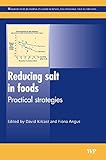Reducing salt in foods : practical strategies
Publication details: Cambridge, Woodhead Publishing, 2007Description: 383pISBN: 9781845690182Subject(s): Healthy eating | Salt content | Dietary intake | Food texture | Food labellingLOC classification: TP370Online resources: Click here Summary: Concerns have grown that consumption levels of salt are well above those needed for nutritional purposes and that this can lead to adverse effects on health, in particular cardiovascular disease. Consumers are increasingly looking to reduce their salt intake, making salt reduction a priority for food manufacturers. This is not straightforward, though, as salt plays an important role in food preservation, taste and processability.This book is divided into three parts and discusses the major issues concerned with salt reduction and how it may be achieved. Part 1 reviews the key health issues driving efforts to reduce salt, government action regarding salt reduction and the implications of salt labelling. Consumer perception of salt and views on salt reduction and are also discussed. The second part focuses on the technological, microbiological and sensory functions of salt and strategies that can be taken to reduce salt. The final part of the book outlines strategies which have been taken to reduce salt in particular food groups: meat and poultry, seafood, bread, snack foods, dairy products and canned foods.| Item type | Current library | Call number | Copy number | Status | Date due | Barcode |
|---|---|---|---|---|---|---|
| EBOOK | CAFRE Loughry Library ONLINE | EBOOK (Browse shelf(Opens below)) | 1 | Available | 92998-2001 | |
| Book - Standard loan | CAFRE Loughry Library | TP370 (Browse shelf(Opens below)) | 1 | Available | 165102 |
Browsing CAFRE Loughry Library shelves, Shelving location: ONLINE Close shelf browser (Hides shelf browser)
Concerns have grown that consumption levels of salt are well above those needed for nutritional purposes and that this can lead to adverse effects on health, in particular cardiovascular disease. Consumers are increasingly looking to reduce their salt intake, making salt reduction a priority for food manufacturers. This is not straightforward, though, as salt plays an important role in food preservation, taste and processability.This book is divided into three parts and discusses the major issues concerned with salt reduction and how it may be achieved. Part 1 reviews the key health issues driving efforts to reduce salt, government action regarding salt reduction and the implications of salt labelling. Consumer perception of salt and views on salt reduction and are also discussed. The second part focuses on the technological, microbiological and sensory functions of salt and strategies that can be taken to reduce salt. The final part of the book outlines strategies which have been taken to reduce salt in particular food groups: meat and poultry, seafood, bread, snack foods, dairy products and canned foods.









There are no comments on this title.